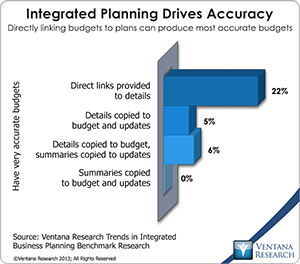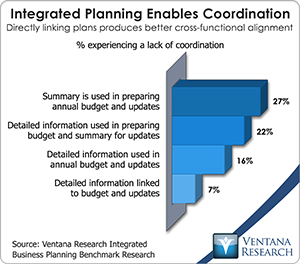Business planning is a new software category. These applications enable senior executives to integrate all the plans of business units into a single, integrated view, which helps them have more accurate plans, do more insightful what-if planning, achieve greater agility in reacting to changing business and economic conditions, and execute plans in a more coordinated fashion than was possible. Business planning  software is intended for CEOs and COOs, who are not well served by current capabilities. Business planning software enables executives and managers to understand both the operational and the financial consequences of their actions, but it emphasizes the things that the various parts of the business focus on: units sold, sales calls made, the number and types of employees required, customers serviced and so on. Lines of business already do this but in a fragmented fashion using desktop spreadsheets circulated within silos via email. Business planning software provides a platform to support modeling in individual business units, individual planning processes and visualization of the impacts of changes in what-if scenarios. It offers a central data repository for all plans; our benchmark research shows the advantage of this approach: Companies that directly link individual business unit data to an integrated plan get more accurate results. To be specific, 22 percent of those with such links have very accurate budgets compared to just a handful with less direct links and none that employ summarized data.
software is intended for CEOs and COOs, who are not well served by current capabilities. Business planning software enables executives and managers to understand both the operational and the financial consequences of their actions, but it emphasizes the things that the various parts of the business focus on: units sold, sales calls made, the number and types of employees required, customers serviced and so on. Lines of business already do this but in a fragmented fashion using desktop spreadsheets circulated within silos via email. Business planning software provides a platform to support modeling in individual business units, individual planning processes and visualization of the impacts of changes in what-if scenarios. It offers a central data repository for all plans; our benchmark research shows the advantage of this approach: Companies that directly link individual business unit data to an integrated plan get more accurate results. To be specific, 22 percent of those with such links have very accurate budgets compared to just a handful with less direct links and none that employ summarized data.
Business planning software is structured to enable rapid creation of an integrated company plan, workflows to manage the periodic updates to an integrated plan, analytics to support planning, and review and reporting functionality to support collaboration on plans and to communicate results. Because business planning requires collaboration, applications must have built-in social collaboration capabilities in context. Integrating individual business unit plans also promotes better coordination across a corporation. Companies in our research that plan using summarized business data much more often reported a lack of coordination than those that directly link their plan details: 27 percent of those that summarize data experience a lack of coordination in reacting to changing business conditions, compared to just 7 percent of those with direct links. To facilitate planning among today’s dispersed organizations, mobile capabilities supporting plan creation and review are essential.
Planning is not the same as budgeting, as I’ve noted. It has different  objectives. Planning is the process of determining what it will take to achieve business goals. Budgeting is about maintaining control of finances so a company doesn’t fail. Planning must be open-ended. Planners must think multiple steps ahead to consider a range of possible outcomes and how to respond to them. Budgeting, in contrast, is a process of narrowing down. It is about getting to a fixed agreement on what financial resources will be available and how they will be allocated. Business plans must constantly change to adapt to conditions and look forward at least five or six quarters. Budgets change only infrequently and almost always are confined to a single fiscal year. Budgeting mainly serves the needs of the CFO and the finance organization. Business planning serves the needs of the CEO, COO and senior operating executives as well as the CFO. Thus budgeting and planning are fundamentally different, but they must be connected. You can’t budget effectively without a plan, and you can’t plan effectively unless you consider fiscal constraints. At the same time, the two shouldn’t be homogenized, which is the way almost all companies do planning and budgeting today.
objectives. Planning is the process of determining what it will take to achieve business goals. Budgeting is about maintaining control of finances so a company doesn’t fail. Planning must be open-ended. Planners must think multiple steps ahead to consider a range of possible outcomes and how to respond to them. Budgeting, in contrast, is a process of narrowing down. It is about getting to a fixed agreement on what financial resources will be available and how they will be allocated. Business plans must constantly change to adapt to conditions and look forward at least five or six quarters. Budgets change only infrequently and almost always are confined to a single fiscal year. Budgeting mainly serves the needs of the CFO and the finance organization. Business planning serves the needs of the CEO, COO and senior operating executives as well as the CFO. Thus budgeting and planning are fundamentally different, but they must be connected. You can’t budget effectively without a plan, and you can’t plan effectively unless you consider fiscal constraints. At the same time, the two shouldn’t be homogenized, which is the way almost all companies do planning and budgeting today.
To this point technology has mainly constrained the planning and budgeting processes. The process of collecting information to create a budget, performing calculations and basic analyses and creating reports was highly labor-intensive in the days of paper spreadsheets and adding machines, so simplification was required. Electronic spreadsheets enabled companies to do more detailed budgets, but only up to a point. Both approaches required the actual business plans (such as “Here’s what we plan to sell at the following prices” or “Here are the people we need to staff this department by function”) to be subsumed into the budget. This homogenized approach, which I call “budgetingandplanning,” prevents the kind of practical business planning that is useful to senior executives. It erects a barrier to adapting quickly to changing conditions. On the other hand, business planning software enables decision-makers to measure the impacts of the trade-offs they’re considering and rapidly calculate the impact of different courses of action from both operational and financial perspectives in the context of their key performance metrics.
To be productive, planning must be a structured dialogue, structured in the sense that it involves hard numbers. Measurement is necessary to set objectives and assess performance. A back-and-forth discussion helps planners agree upon objectives with which to measure success. If getting to the hard numbers at each stage of the discussion takes too long, the conversation becomes stilted and may have to be cut short because of deadlines to make decisions. If running a set of corporate-wide what-if scenarios takes hours or days, there will be no time for dialogue. In that case business planning defaults to individual silos, and the budget becomes the single integrated corporate plan. Even if response times can be cut to five to 10 minutes, that’s still too slow. The conversation must be unbroken.
Today’s business planning software can run even complex scenarios in seconds or less, enabling companies to change the way they plan and review. Using in-memory processing it can deliver answers fast enough to support a structured dialogue. Big data analytics can be used to quickly deliver insights and guidance to inform planning and review conversations. At long last business planning technology is able to facilitate a business-focused approach to planning. By providing better insight and visibility into potential outcomes, executives and managers can make more informed choices about their courses of action. The software is available to enable a more effective business process, but the question is how quickly senior executives will take advantage of it.
Regards,
Robert Kugel – SVP Research













